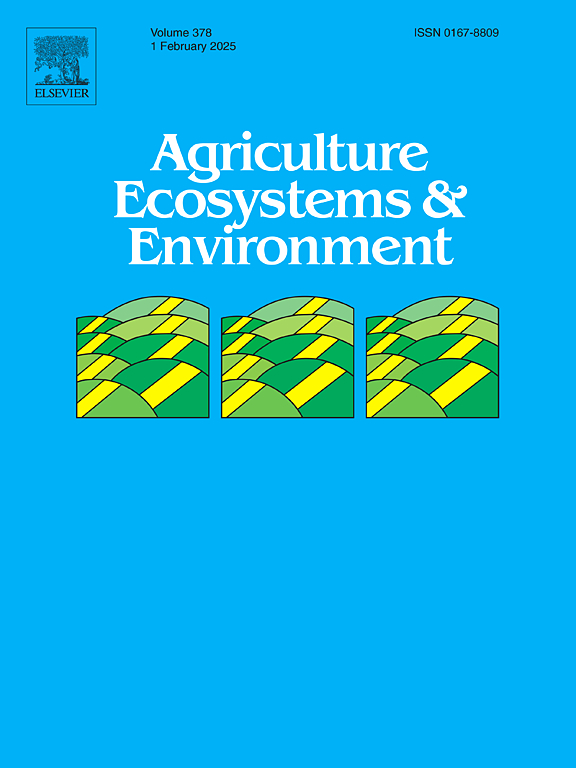在半自然栖息地丰富的景观中,作物异质性可能不会加强对水稻害虫的生物防治
IF 6
1区 农林科学
Q1 AGRICULTURE, MULTIDISCIPLINARY
引用次数: 0
摘要
世界范围内的农业景观正经历着深刻的变化,包括作物同质化和半自然栖息地的丧失,这可能对作物害虫的节肢动物天敌不利,尽管这些驱动因素之间的交互作用仍未得到充分研究。我们在中国海南岛的 17 块稻田中,评估了作物多样性、平均田块面积和半自然栖息地比例对水稻害虫及其节肢动物天敌(捕食者和寄生虫)的丰度和多样性在四个空间尺度(100 米、250 米、500 米和 1000 米)上的相对贡献。水稻田害虫和天敌的总体丰度较低,表明生物防治水平较高。半自然栖息地(包括一些最近恢复的栖息地)在所研究的景观中占有很大比例(平均比例为 65%),可能是生物多样性的宝库。事实上,田地平均面积的减少和半自然生境比例的增加仅在最大空间尺度上促进了水稻害虫的生长,这可能是通过提高它们的流动性和对替代资源的利用来实现的。捕食者的反应较弱,表明半自然栖息地(或在没有半自然栖息地的情况下作物多样性)在小空间尺度上有积极影响。寄生虫丰度较低,但倾向于支持资源集中假说(作物多样性减少,平均田块面积增加)。总体而言,作物异质性有利于害虫,但不利于天敌,其两个组成部分--平均田块面积缩小和作物多样性增加在某种程度上是互补的,并受半自然生境比例的调节,但取决于空间尺度。本文章由计算机程序翻译,如有差异,请以英文原文为准。
Crop heterogeneity may not enhance biological control of rice pests in landscapes rich in semi-natural habitats
Agricultural landscapes are undergoing profound changes worldwide, including crop homogenization and loss of semi-natural habitats, which may be detrimental to arthropod natural enemies of crop pests, although interactive effects between these drivers remain understudied. We assessed the relative contribution of crop diversity, mean field size and the proportion of semi-natural habitats on the abundance and diversity of rice pests and their arthropod natural enemies (predators versus parasitoids) across four spatial scales (100, 250, 500 and 1000 m) in 17 rice fields in Hainan Island, China. The overall low abundance of pests and natural enemies measured in rice fields could indicate high biological control level. Semi-natural habitats (including some recently restored ones) were largely represented in the studied landscapes (average proportion of 65 %) and may be biodiversity reservoirs. Indeed, decreased mean field size and increased semi-natural habitat proportion promoted rice pests at the largest spatial scale only, possibly by enhancing their mobility and use of alternative resources. Predators’ response was weak and indicated a positive influence of semi-natural habitats (or crop diversity in absence of semi-natural habitats) at small spatial scales. Parasitoid abundance was low, but tended to support the resource concentration hypothesis (reduced by crop diversity and increased by mean field size). Overall, crop heterogeneity favoured pests, but not natural enemies, its two components reduced mean field size and increased crop diversity were somewhat complementary and modulated by the proportion of semi-natural habitats but depended on spatial scale.
求助全文
通过发布文献求助,成功后即可免费获取论文全文。
去求助
来源期刊

Agriculture, Ecosystems & Environment
环境科学-环境科学
CiteScore
11.70
自引率
9.10%
发文量
392
审稿时长
26 days
期刊介绍:
Agriculture, Ecosystems and Environment publishes scientific articles dealing with the interface between agroecosystems and the natural environment, specifically how agriculture influences the environment and how changes in that environment impact agroecosystems. Preference is given to papers from experimental and observational research at the field, system or landscape level, from studies that enhance our understanding of processes using data-based biophysical modelling, and papers that bridge scientific disciplines and integrate knowledge. All papers should be placed in an international or wide comparative context.
 求助内容:
求助内容: 应助结果提醒方式:
应助结果提醒方式:


